When Star Trek: Discovery debuted in 2017, it was billed as a show that followed “the adventures of Starfleet.” The show wasn’t just about the voyages of the starship Discovery, but also the USS Shenzhou and, eventually, the USS Enterprise. But now, in season 3, it looks like Discovery is all that is left of Starfleet, and the Federation is down to just a handful of member planets. At New York Comic Con, a new trailer gave us the first glimpse of the wilder, grittier Discovery. Now that the crew has landed 930 years in the future (they jumped from 2257 to 3187 in the blink of an eye) the landscape of Star Trek is suddenly very different.
Based on the short trailer, here are the six biggest questions about Star Trek: Discovery season 3, and what the answers to those questions might mean for the future of the franchise.
Trailer spoilers ahead!
6. Six planets are left in the Federation, but what are they?

In what is probably the most shocking part of the trailer, Burnham encounters someone who appears to be a lonely survivor of the United Federation of Planets. But now, the flag of the Federation only has six stars on it, whereas in the 24th Century there were about 150 planets in the Federation. In old-school canon, the three biggest stars on the Federation flag used to represent Earth, Vulcan, and Andoria, since those were a few of the founding planets of the Federation. But, now that there’s only six, which planets are these stars supposed to represent? And is Earth even one of them?
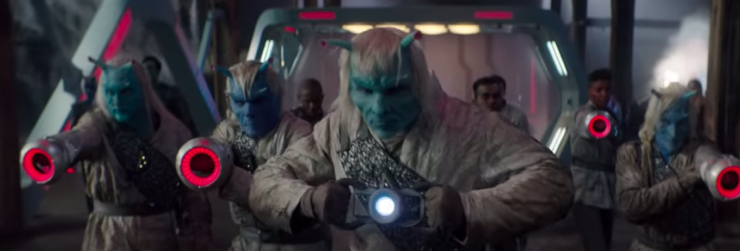
5. Are the Andorians the bad guys now? (And are those even Andorians?)
Speaking of Andorians, we see the classic original series aliens at several points in the trailer brandishing what seems like a new kind of sonic weapon. This might suggest that the Andorians are no longer part of whatever joke-version of the Federation still exists. But, upon closer inspection, there’s a bigger question: Are those Andorians? Sure, they’ve got the blue skin and the antennae made famous in “Journey to Bablel” and the series Enterprise, but there’s something about them that feels different. In one shot it almost looks like they are wearing Klingon sashes while being flanked by human support soldiers. So: Are these genetic mash-ups? Did the Andorians merge with the Klingons? This is Discovery, so stranger things have happened before.

4. How much time passes during this season?
Throughout the trailer, we see Michael Burnham with various different hairstyles, and her voiceover implies she’s been doing something for “a year.” Does that mean more than a year will pass during this season? And if so, why? What has Michael Burnham been doing and has it kept her away from Discovery? And will the season really keep her separated from her best friends?
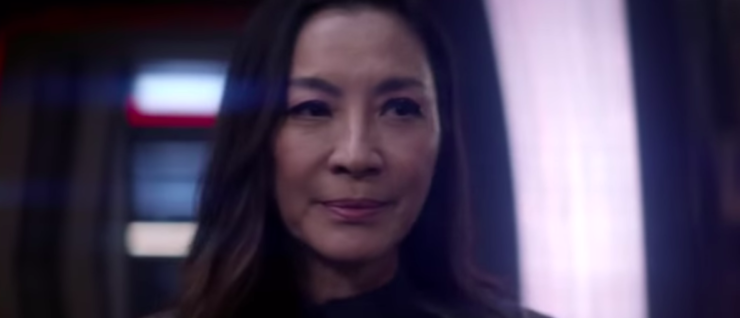
3. Who is the new captain of the USS Discovery?
One of the biggest questions every fan has about the new season is who will become the new captain of the ship now that Captain Pike has been left behind, where he belongs, in the 23rd century. One very quick shot shows Georgiou wearing a Starfleet uniform, suggesting that perhaps, she tries to take command of the ship. It wouldn’t be the first time, either. Back in season 1, Starfleet had Georgiou pretend to be her Prime universe counterpart, and for all we know, a lot of people on Discovery might still think she is Prime Georgiou. Obviously, Michael, Tilly, Stamets, and Saru know she’s not “really” Captain Georgiou from the good universe, but what if no one else knows that? And what if the lower-ranking crew members can’t prove it? Also, because the trailer strongly suggests Michael is separated from Discovery for part of the season, maybe Georgiou takes command in her absence.
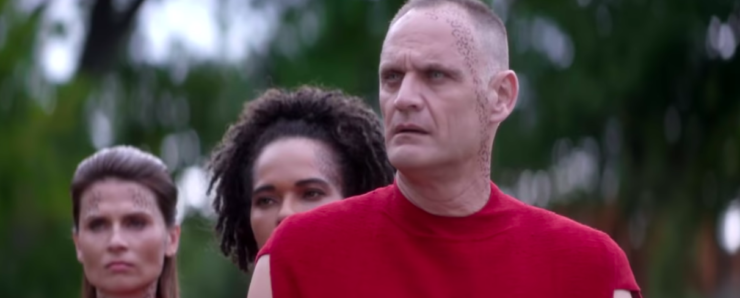
2. Why are the Trill back? (And Is Burnham about to be joined?)
Though the new future of Star Trek is largely different than we’ve ever seen before, there is one thrilling Easter egg here for fans of Star Trek: Deep Space Nine: those Trill spots are back! In several scenes, we see people who are clearly members of the Trill race, and it even looks like Michael Burnham is headed into some familiar Trill caves. As a refresher: Trill are a race of aliens composed of a humanoid body and a slug-like symbiont. The most famous Trek Trill is Dax, who took the form of Kurzon, Jadzia and Ezri Dax during the run of Deep Space Nine. So, if the Trill are back, Dax could conceivably be there, albeit in a different body. (That guy right there could be Dax! Really!) Plus, because the Trill symbionts are so long-lived, this could imply they’re the only people who know what’s happened to the galaxy in the past 930 years.
Finally, one scene really makes it look like Michael Burnham is wading in those Trill pools. Does that mean she’s about to be joined? Are we looking at Michael Burnham Dax? Even if it was temporary, this kind of thing has happened before. Riker carried a little Trill in his belly for a while back in the very first Trill episode ever, “The Host.”
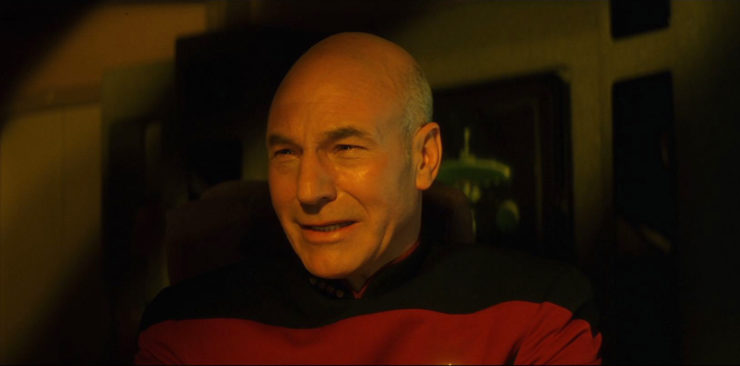
1. Is this Gene Roddenberry’s Federation?
So, because the “utopian” United Federation of Planets seems to be either defunct or in a serious slump, some supposed Trek purists may cry foul and say that without the Federation, you can’t have Star Trek and that Disocovery is somehow desecrating Gene Roddenberry’s hopeful idealized future. This argument will be floated a lot and in all cases, it will be wrong. The idealized Federation has always been fraught and has had a hard time justifying its own rules. (See: all cases of the Prime Directive.) Plus, the entire premise of this season of Discovery feels very-much in line with another series created by Gene Roddenberry and produced posthumously. In the 2000-2005 series, Andromeda, a lone starship finds itself in a future where a benevolent government called “The Commonwealth” no longer exists. Sound familiar? Discovery is basically pulling an Andromeda, meaning this is about as Gene Roddenberry as any new version of Star Trek can get.
Star Trek: Discovery season 3 debuts sometime in 2020.
Ryan Britt is a longtime contributor to Tor.com. His other science fiction essays and journalism have been published by SyFy Wire, Den of Geek!, Inverse, Vulture, and StarTrek.com He is the author of the essay collection Luke Skywalker Can’t Read (Penguin Random House) and an editor at Fatherly.










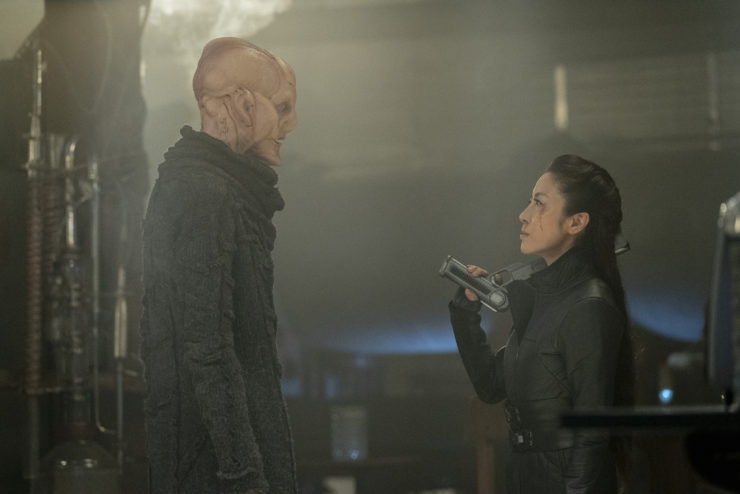
It’s hard not to think of this as Gene Roddenberry’s Andromeda with the serial numbers restored.
On point 6: Star Trek canon has never defined what the stars on the UFP flag mean. A conversation about flag design would be kind of a drag in a TV episode or movie, so it’s never actually come up onscreen. And there have been multiple different designs by different graphic designers, all with different numbers and configurations of stars. There’s exactly zero reason to believe the number of stars represents anything about the number of members. Besides, the founding members were Earth, Vulcan, Andor, Tellar, and Alpha Centauri according to conventional lore, and ENT confirmed at least the first four of those as founding members; so why would there be only three stars highlighted if they were supposed to represent the founders? This is pure fan conjecture, a clumsy attempt to “explain” something that has no other meaning beyond looking cool. So point #6 holds no water.
On point 5: Seriously? You see something sash-like and assume its wearer must be genetically part-Klingon? Since when have clothes been genetically determined? Since when have Klingons had a monopoly on sash-like decorations?
On point 1: Andromeda was, in fact, partly based on former DS9 co-showrunner Robert Hewitt Wolfe’s unused thoughts about what kind of Trek spinoff he’d create, involving a fall-of-the-Federation scenario. Despite its name, little of its premise actually came from Gene Roddenberry; it was basically a loose reworking of his ’70s pilot movies Genesis II and Planet Earth, in which 20th-century scientist Dylan Hunt (Alex Cord, then John Saxon) was cryogenically frozen and awoke in a post-apocalyptic 2133, where he joined an organization working to rebuild civilization. Roddenberry probably cribbed aspects of the idea for the “Post-Atomic Horror” mentioned in TNG’s pilot episode, so we know there was room in Roddenberry’s view of Trek for hard times that inspired humanity to rebuild better than before.
Similarly, the aborted Star Trek: Final Frontier animated series proposal back in 2006 involved a 26th-century Enterprise in a darker, fragmented Federation after a galactic disaster. Probably anyone who’s ever read The Foundation Trilogy has speculated about the eventual fall of the Federation, so it was only a matter of time before someone used the idea.
Presumably the fate of the galaxy or universe isn’t at stake this time, so that’s a plus. I don’t know though, there’s something deeply unsatisfying to me about concentrating on former glories like the Federation. I think I would prefer an entirely new structure, even new species. Star Trek spends way too much time looking back at itself, and the previous two seasons were no exceptions.
Supposed Trek purist here.
I never liked Andromeda. The 23rd century Prime Directive was fine; it only became objectionable in the 24th century. I strongly disagree with the claim that the “Federation has always been fraught”. It has always been imperfect, like everything people build. But still a better society.
This supposed Trek purist isn’t interested in the question how “Gene Roddenberry” a Trek show is, only in the question if it still portrays such a better society.
By the way, the Star Trek I originally fell in love with wasn’t created by Roddenberry alone. Gene Coon, Dorothy Fontana and many others had a part in it, too.
I would just like to know when Discovery is going to air?
It looks like Saru is giving a rousing “Captain’s speech” in one scene, and he should be the Captain if Starfleet follows the usual chain of command
So it’s been suggested from Calypso that the Federation had been corrupted/become authoritarian. My fear is that this is trying to be some heavy handed anti-alt-right message talking about heritage in lieu of bad behavior.
For those unfamiliar with our Moderation Policy, you can find the full guidelines here. Comments violating these guidelines will be unpublished, and repeat offenders may be banned from participating in the discussion. Please consider this a final warning.
No reason why there shouldn’t be Trill in the future, but it would sure be nice if they came up with a new species of alien for a change.
I’m happy Trills are back, they are criminally underused in Star Trek. I hope we see Dax again in a new host. Jadzia is my favorite character but I didn’t like Ezri so a new host would be more than welcomed. A clone of Jadzia would be even better!
It is my recollection that the Andromeda Ascendant was significantly more powerful than anything that Starfleet ever fielded, so if the deal is that they want to rebuild Starfleet and the Federation, Discovery has its work cut out for it.
@11/roxana: To me, the problem with Star Trek has often been that it doesn’t reuse aliens enough. Many productions have introduced new background aliens that later productions ignored and replaced with other background aliens or guest species of the week, which undermined the sense of a continuous, shared reality. For instance, Discovery is the first time since ST:TMP that we’ve seen a Saurian onscreen.
If it’s a story about holding humanity to higher ideals, the ideals the Federation was founded on and at its best embodies, sounds like Star Trek to me and I’m all for it.
Utopia is a dramatic dead-end, which is why early TNG struggled so much. TOS wasn’t a utopia. The future was better, but it wasn’t Paradise. So having a future where they have to actually work to make things better is better dramatically than having a dull future of faster warp drives, tighter uniforms and smug people lecturing the audience how superior they are.
@16/Almuric: Agreed. But tearing it all down to build it anew is going to the other extreme. The TOS future was a good starting point for all kinds of stories, always with the underlying message that societal progress is possible. Tearing this society down inevitably carries the message that no good thing can last. Not quite the same philosophy.
@17. I’m pretty sure they’ll be rebuilding it, and better than before.
@18/Almuric: Doesn’t matter. The message remains. Besides, if the first two seasons are anything to go by, their idea of a better future and mine don’t coincide.
@17/Jana: It’s too early to assume from a single trailer that the entire Federation has fallen. Diminished, fragmented, probably, but clearly an element of it endures. At this point we’re just extrapolating from a few glimpses; we don’t know for certain what they add up to. The thing to do with fragmentary information is not to fill it in with guesswork and then get angry about your own guesses. The thing to do is be patient and wait for more information before you decide anything.
@20/Christopher: I’m not angry. Sorry if that’s how it came across. I’ve come to see modern Star Trek as fanfiction, so it doesn’t bother me anymore. But I still find it interesting to discuss the different philosophies.
Fanfiction is a hobby. This is paid professional work, whatever you think of it.
@22/Christopher: So apparently I didn’t use the term in a strictly literal sense.
She just means “it’s not canon” to her.
@24/MaGnUs: Ugh, that’s an even worse misuse of terminology than calling it fanfiction.
@24/MaGnUs: Thank you.
@25/Christopher: It’s a widening of meaning, like the earlier usage of “canon” for literary instead of religious texts.
@21 et al: I believe the technical term is “fanon discontinuity”.
@27/cap-mjb: I’m not sure how to use that in a sentence.
@26/Jana: Widenings are one thing, but using a word in the exact opposite of its intended sense is another thing. The entire reason the word “canon” exists is to refer to the stuff from the original source as opposed to variant interpretations by other parties. So “what I decide is canon” isn’t widening the definition, it’s just an oxymoron. It’s so diametrically opposed to the word’s true meaning that it robs it of all meaning.
I’ve always though of it as “personal continuity.” People often say “canon” when they mean “continuity,” which just leads to confusion because they then mistakenly expect canons to be continuous by default, which they often aren’t. A “widening” that leads to confusion and misunderstanding should be discouraged. Discussions of continuity would be so much clearer and easier if people hadn’t started confusing continuity and canon.
@28/JanaJansen: I guess it would just be “I’ve come to see modern Star Trek as fanon discontinuity.”
Personal continuity works for me. I’ve been picking and choosing what I will include in mine for decades now.
Have to admit, this makes me miss Anson Mount’s Pike. I thought the Angel plot was nonsensical but I greatly enjoyed having Mount as the captain of Disco. Strangely, I saw a couple of episodes of the Inhumans and had no interest in his Black Bolt, but I find him hugely charismatic as Pike. Since we got a Short Trek with Number One and Spock, I wonder if we are going to see more of the Enterprise crew some day?
I hope the fate of the galaxy doesn’t rest on Burnham’s shoulders yet again, as much as I like that character.
@32 I didn’t even realize he was in Inhumans and I’d wanted to like Black Bolt.
Looking forward to the mystery of Andorian appearance in season 3!